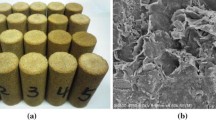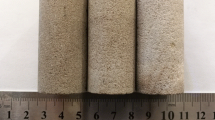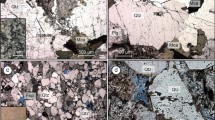Abstract
The influence of hydrostatic and uniaxial stress states on the porosity and permeability of sandstones has been investigated. The experimental procedure uses a special triaxial cell which allows permeability measurements in the axial and radial directions. The core sleeve is equipped with two pressure samplers placed distant from the ends. They provide mid-length axial permeability measure as opposed to the overall permeability measure, which is based on the flow imposed through the pistons of the triaxial cell. The core sleeve is also equipped to perform flows in two directions transverse to the axis of the sample. Two independent measures of axial and complementary radial permeability are thus obtained. Both Fontainebleau sandstone specimens with a porosity of about 5.8% to 8% and low permeability ranging from 2.5 mD to 30 mD and Bentheimer sandstone with a porosity of 24% and a high permeability of 3D have been tested. The initial axial permeability values obtained by each method are in good agreement for the Fontainebleau sandstone. The Bentheimer sandstone samples present an axial mid-length permeability 1.6 times higher than the overall permeability. A similar discrepancy is also observed in the radial direction, also it relates essentially to the shape of flow lines induced by the radial flow. All the tested samples have shown a higher stress dependency of overall and radial permeability than mid-length permeability. The effect of compaction damage at the pistons/sample and radial ports/sample interfaces is discussed. The relevance of directional permeability measurements during continuous uniaxial compression loadings has been shown on the Bentheimer sandstone until the failure of the sample. We can efficiently measure the influence of brittle failure associated to dilatant regime on the permeability: It tends to increase in the failure propagation direction and to decrease strongly in the transverse direction.
Similar content being viewed by others
Author information
Authors and Affiliations
Corresponding author
Rights and permissions
About this article
Cite this article
Dautriat, J., Gland, N., Guelard, J. et al. Axial and Radial Permeability Evolutions of Compressed Sandstones: End Effects and Shear-band Induced Permeability Anisotropy. Pure appl. geophys. 166, 1037–1061 (2009). https://doi.org/10.1007/s00024-009-0495-0
Received:
Revised:
Accepted:
Published:
Issue Date:
DOI: https://doi.org/10.1007/s00024-009-0495-0




